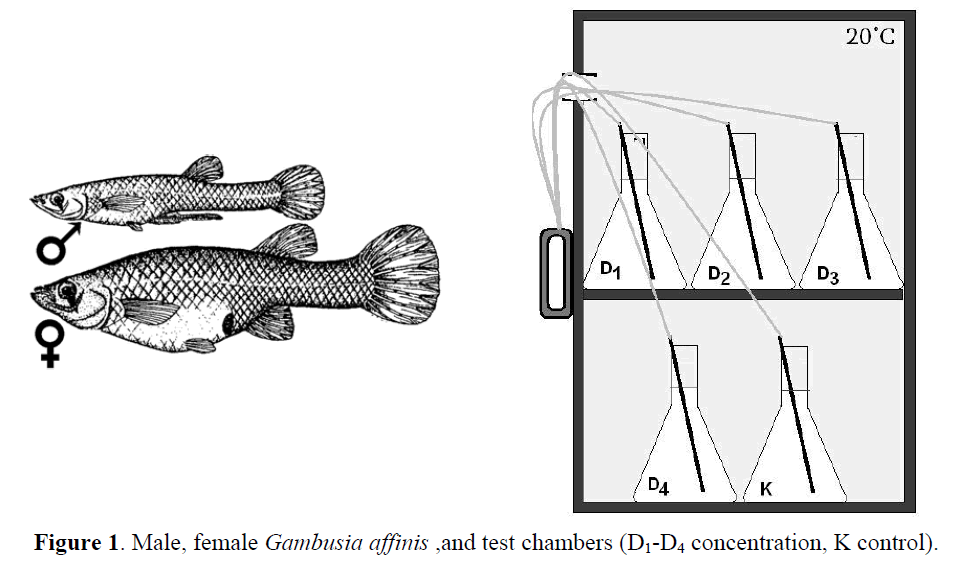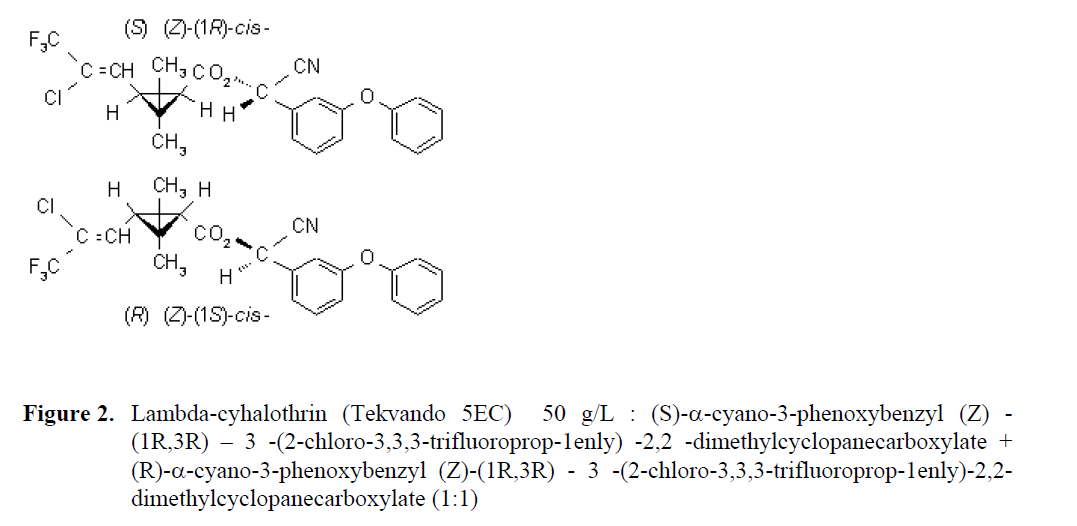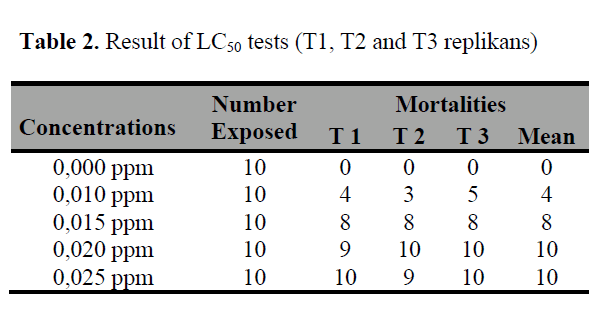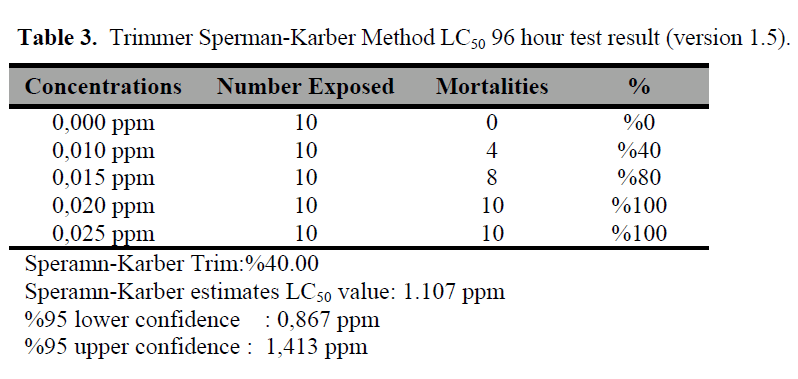Keywords
Lambda cyhalotrin, Gambusia affinis, Lethal Concentration 50
Introduction
Not only, pesticides play an important role in modern agriculture by providing dependable, persistent and relatively complete control against harmful pests with less expense and effort but also they have, no doubt, increased crop yields by killing different types of pests, which are known to cause substantial or total crop damage. On the other hand, these chemicals are considered as potent pollutants of the water environment with undesirable effects on non-target organisms such as fish and water animals (Atamanalp and Yan?k 2001; Anomouse 1988, 1991).
Lambda cyhalothrin is a pyrethroid insecticide, highly active against a wide range of species of Lepidoptera, Hemiptera, Diptera, and Coleoptera (Bao at al, 2007). Lambda-cyhalothrin has the same spectrum of insecticidal activity as cyhalothrin, but is more active. The compound is a stomach and contact insecticide. It shows adulticidal, ovicidal and particularly, larvicidal activity (Anomouse 1991).
Apart from agricultural uses, lambda cyhalothrin also has public and animal health applications in which it effectively controls a broad spectrum of insects including cockroaches, flies and ticks. And also it is used in the vector control such as mosquito control by direct spraying in the water bodies (Velmurugan at al, 2007).
Pyrethroids Insecticides such as lambda cyhalothrin is extremely toxic to many aquatic organisms, including fish such as the blue gill and lake trout, with LC50 values less than 1.0 μg/L (Mueller-Beilschmidt, 1990). Due to their lipophilicity, pyrethroids have a high rate of gill absorption, which in turn would be a contributing factor in the sensitivity of fish to aqueous pyrethroid exposures (Polat et al, 2002). Lambda cyhalothrin is not only toxic for many fish but also toxic many aquatic invertebrate species (Paul and Simonin 2006, Taplo 1). Reported LC50s in these species are as follows: bluegill sunfish, 0.21 μg/L (Anomouse, 1991 1998); rainbow trout, 0.24 μg/L (Anomouse 1991, 1998); Daphnia magna, 0.36 μg/L; mysid shrimp, 4.9 ng/L; sheepshead minnow, 0.807 ng/L (Anomouse 1998). A median effect concentration, EC50 (i.e. the concentration at which the effect occurs in 50% of the test population), for the eastern oyster of 0.59 ng/L has been reported (Anomouse 1998).
Bioconcentration is possible in aquatic species for lambda cyhalotrin, but bioaccumulation is not likely because of rapid depuration (elimination) (Wauchope et al., 1992). A bioconcentration factor of 858 has been reported in fish (4 species unspecified) for lambda cyhalotrin, but concentration was confined to non-edible tissues and rapid depuration was observed (Anomouse 1998).
Pyrethroids have become widely used on rice in some countries (Bao et al., 2007, Anomouse 1998, 1991), but their application in paddy Weld have been prohibited in China because of their high toxicity to aquatic animals (Köprücü and Aydin, 2004; Çakmak and Gorgon, 2003). In Turkey especially Turkish Thrace, the use of Lambda cyhalotrin has been increased on same kind of insect (such as Lepidoptera, Hemiptera, Diptera and Coleoptera) in some years (Erkin and Ki?mir 1996). About 20 percent of pesticent were used in Turkish tharce. Lambda cyhalothrin runoff from agricultural fields killed natural fish in masses in various parts of the world also, research has shown that exposure to lambda cyhalothrin, even at sublethal doses, induces behavioral and biochemical changes in fish (Bao et al., 2007, Anomouse 1998, 1991).
Since Gambusia affinis are widespread and use for biological control of mosquitoes and also one of the most used animals for determinations of LC50 values, therefore, this study was undertaken to calculate LC50 value of lambda cyhalothrin for 96 hour in Gambusia affinis.
Materials and Methods
Test Animals
Gambusia affinis (Baird and Girard, 1853) belongs to family Poeciliidae (Poeciliids), subfamily Poeciliinae and inhabits slow-flowing water; most common in vegetated ponds and lakes, backwaters and quiet pools of streams. Gambusia affinis feeds on zooplankton, small insects and detritus and used as live food for carnivorous aquarium fishes (Page and Burr 1991).
LC50 test
About 200 adult Gambusia affinis specimens were collected from Gülapo?lu Lake, Edirne city. The fish used were adults, both females and males between 25 and 35 mm total length (about <1 g). They were transferred to four glass aquarium (50x50x100 cm, 100 l) in the aquarium room and maintained at 20°C and 16:8 light: dark regime. This arrangement was left undisturbed for seven days, during which animals became accustomed to room conditions.
The experiments were conducted in 2 l glass tanks, each contained 2 l solution with different concentrations of test substances or negative control, and 10 organisms were tested in one glass tank (Figure 2). All experiments were performed with three replicates. Tap water was aerated for dechlorinating pretreatment by air pump for over 24 h (Figure 1).

Figure 1: Male, female Gambusia affinis ,and test chambers (D1-D4 concentration, K control).

Figure 2: Lambda-cyhalothrin (Tekvando 5EC) 50 g/L : (S)-α-cyano-3-phenoxybenzyl (Z) - (1R,3R) – 3 -(2-chloro-3,3,3-trifluoroprop-1enly) -2,2 -dimethylcyclopanecarboxylate + (R)-α-cyano-3-phenoxybenzyl (Z)-(1R,3R) - 3 -(2-chloro-3,3,3-trifluoroprop-1enly)-2,2- dimethylcyclopanecarboxylate (1:1)
Semi-static exposure to the testing substances was applied, with replacement of testing solution every 48 hours. The exposure lasted for 96 hour, and symptoms and mortality were recorded at 24, 48, and 96 hour post treatment.
Chemical
Lambda-cyhalothrin (mixture 1:1 of S and R isomers); molecular Formula C23H19ClF3NO3 (CAS no: 91465-08-6), emulsion concentration is 50 mg/l (Figure 2). Commercial grade llambda cyhalothrin (Tekvando 5EC) (proved by Sefa Tar?m A.?, Turkey) was used in this study.
Statistical Analysis
Statistical analysis was performed using LC50 Trimmed Spearman–Karber Program (1.5 versions). The median lethal concentrations, LC50 (96 hour) and 95% confidence interval were calculated statistically by the Trimmed Spearman– Karber method (Martin et al., 1977).
Results and Discussion
Water parameters during the experiment remained constant as follows: dissolved oxygen 13.13±1.71 mg/l, temperature 20 ±1 °C, pH 8.30 ±0.24, and conductivity 621.68 ±11.13 μhos.
LC50 experiments were performed with three replicates (Table 2). At end of 96 hour, lethal concentration 50 calculated special computer program (Martin et al., 1977) (Table 3).

Table 1: Some Pyrethroids LC50 values (from Chavasse & Yap 1997)

Table 2: Result of LC50 tests (T1, T2 and T3 replikans)

Table 3: Trimmer Sperman-Karber Method LC50 96 hour test result (version 1.5).
The median lethal concentration, LC50 (for 96 hour) and 95% confidence interval were calculated as table 2.
Under laboratory conditions of constant toxicant concentrations, lambda-cyhalothrin was highly toxic for fish and aquatic invertebrates. The LC50s (for 96 hour) for fish ranged between 0.2 and 1.3 μg/L; the LC50s (for 48 hour) for aquatic invertebrates ranged between 0.008 and 0.4μg/L. Lambda cyhalothrin is very highly toxic to many fish and aquatic invertebrate species (Paul and Simonin 2006). Reported LC50s in these species are as follows: bluegill sunfish, 0.21 ug/l (Kidd and James 1991,); rainbow trout, 0.24 ug/l (Anomouse 1998); Daphnia magna, 0.36 ug/l (Anomouse 1998); mysid shrimp, 4.9 ng/L (Anomouse 1998); sheepshead minnow, 0.807 ng/L (Anomouse 1998). A median effect concentration, EC50 (i.e. the concentration at which the effect occurs in 50% of the test population), for the eastern oyster of 0.59 ng/L has been reported (Anomouse 1998).
Because agricultural insecticides have potential to disrupt biological control of mosquitoes, we quantified whether an insecticide used in rice fields causes mortality of mosquitofish. Laboratory studies have shown that lambda-cyhalothrin (Tekvando 5EC) is very toxic to fish; however, some studies report low field toxicities of pyrethroids to fish because they degrade rapidly and adsorb to soil. At same time some research shows that Warrior (another lambda-cyhalothrin pesticide like Tekvando 5EC) kills mosquitofish under field conditions. Replicated enclosures in a rice field were either sprayed with Warrior at 5.8 g active ingredient/ha or were untreated. Mosquitofish were either added before the spray or 7 days later. Of those added before the spray, none survived. Most fish added 7 days later, survived (Lawler at al, 2003).
Many biosit LC50 levels were determined for mosquitofish. The reported LC50's for are 0.35 ppm for parathion and 13.45 ppm for methyl parathion (Chambers and Yarbrough, 1974). The LC50 for chlorpyrifos is 0.15 ppm (Scott and Chambers 1996). In many case lambda cyhalothrin LC50 levels is less than 1.0 μg/L for many fishes such as the blue gill and lake trout (Anomouse 1991).
Result of 24 h LC50 test for Gambusia at static condition is 0, 18 μgL for Gambusia at static condition (Mohsen at al, 1989). Under laboratory conditions lambda-cyhalothrin are highly toxic for fish, aquatic arthropods, and honeybees. However, under field conditions, lasting adverse effects are not likely to occur under recommended conditions of use (Anomouse 1991, 1998; Bao at al, 2007).
According to Delistraty (2000) in the study of examining relationships among physicochemical properties and acute toxicity endpoints of some chemicals (such as pesticides) in rats and trout concluded that trout aquatic LC50 was predicted from rat inhalation LC50 with moderate success. Therefore such data are useful in ecological risk assessment but there are limitations and uncertainties. Further work with toxicity testing methods directly on fish will be very useful in assessing possible ecological risk of these pesticides because of changing physicochemical parameters and chemical properties of pesticides.
Conclusions
The present study evaluated lethal concentration for 96 hours effects of one of most used pesticide (lambda-cyhalothrin) on mosquitofish. The calculated value of the 96-hour LC50 of Lambda - solution was 1.107 μg/L (Table 3).
1457
References
- Anomouse, (1991). Royal Society of Chemistry, (as updated). The Agrochemicals Handbook, Royal Society of Chemistry Information Services. Cambridge
- nAnomouse, (1998). US Environmental Protection Agency.Fact Sheet Number 171: Karate Washington, DC, pp 321
- nAtamnalp, M., Yan?k, T., (2001). PestisitlerinCyprinidae’lereToksikEtkileri, EgeUniversity Journal of Fisheries & Aquatic Sciences, in Turkish, 18 (3-4): 555-560
- nBao, G.G., Wang, M.H., William, L.C., Dao, J.C., Zheng, JS., (2007). Risk assessment of -cyhalothrin on aquatic organisms in paddy Weld in China, Regulatory Toxicology and Pharmacology, 48: 69-74
- nÇakmak, M.N., Gorgon, A., (2003). Toxic effect of a synthetic pyrethroid insecticide (Cypermethrin) on blood cells of rainbow trout (Oncorhynchusmykiss, Walbaum), OnLineJournal of Biological Sciences, 3: 694-698
- nChambers, J. E., Yarbrough, J.D., (1979). A seasonal study of microsomal mixed-function oxidase components in insecticide-resistant and susceptible mosquitofish, Gambusiaaffinis, Toxicology and Applied Pharmacology, 48: 497-507
- nChavasse, D.C. Yap, H.H., (1997). Chemical Methods for the Control of Vectors and Pests of Public Health Importance, DocumentWHO/CTD/WHOPES/ 97.2. World Health Organization, Geneva
- nDelistraty, D., (2000). Acute toxicity to rats and trout with a focus on inhalation and aquatic exposures, Ecotoxicology and Environmental Safety, 46: 225–233
- nErkin, E., Ki?mir, A., (1996). DünyadaveTürkiye’deTar?m?laçlar?n?nKullan?m?, In Proceeding of “II.UlusalZiraiMücadele?laçlar?Sempozyumu” in Turkish, 18-20 November, Ankara
- nKidd, H., James, D.R., (1991). The Agrochemicals Handbook, Third Edition. Royal Society of Chemistry Information Services, Cambridge (as updated)
- nKöprücü, K., Rahmi, A., (2004). The toxic effects of pyrethroiddeltamenthrin on the common carp (CyprinuscarpioL.) embryos and larvae, Pesticide Biochemistry and Physiology, 80: 47-53
- nLawler, S.P., Dritz, D.A., Godfrey, L.D., (2003). Effects of the agricultural insecticide lambda-cyhalothrin (WarriorTM) on mosquitofish(Gambusiaaffinis), Journal of the American Mosquito Control Association, 19(4): 430-432
- nMohsen, Z.H., Ouda, N.A., Zaiya, H.H., (1989). Predatory Efficiency and Tolerance of Gambusiaaffinisto Mosquito Larvicides, Journal of Biology Science Research, 20(3): 528- 536
- nMueller-Beilschmidt, D., (1990). Toxicology and environmental fate of synthetic pyrethroids, Journal of Pesticide Reform, 10(3): 32-37
- nPage, L.M., Burr, B.M., (1991). A field guide to freshwater fishes of North America north of Mexico, Houghton Mifflin Company, Boston. Paul E. A., Simonin H. A., (2006). Toxicity of Three Mosquito Insecticides to Crayfish, Bulletin of Environmental Contamination and Toxicology, 76: 614–621
- nPolat, H., Erkoc, F.U., Viran, R., Kocak, O., (2002). Investigation of acute toxicity of beta-cypermethrin on guppies Poecilia reticulate, Chemosphere, 49 (1): 39-44
- nScott, J.B., Chambers, E.J., (1996). Time Courseof Inhibition of Cholinesterase and AliesteraseActivities, and Nonprotein Sulfhydryl Levels Following Exposure to OrganophosphorusInsecticides in Mosquitofish (Gambusiaaffinis), Fundamental and Applied Toxicology, 29: 202 - 207
- nShafiq-ur-Rehman, S., (2006). Endosulfan Toxicity and its Reduction by Selenium: A Behavioral, Hematological and PeroxidativeStress Evaluation. The Internet Journal of Toxicology, 3(1): 345-351
- nVelmurugan, B.,Selvanayagam, M., Cengiz, E,I, Unlu, E., (2007). Histopathology of lambdacyhalothrinon tissues (gill, kidney, liver and intestine) of Cirrhinusmrigala, Environmental Toxicology and Pharmacology, 24: 286-291
- nWauchope, R.D., Buttler, T.M., Hornsby, A.G., Augustijn-Beckers, P.W.M., Burt, J.P. (1992). SCS/ARS/CES Pesticide Properties Database for Environmental Decision making, Reviews of Environmental Contamination and Toxicology, 12: 12-46











